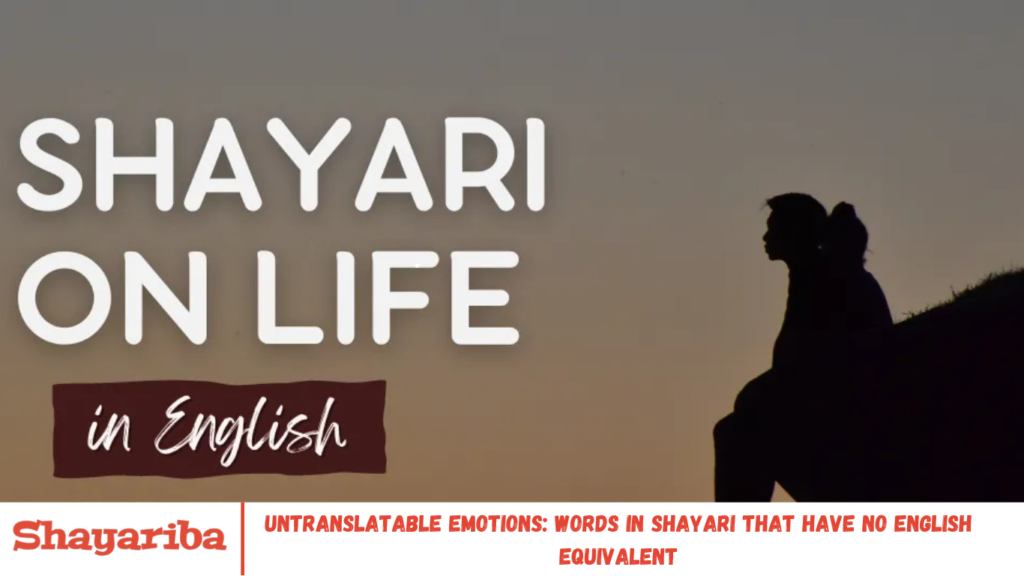Shayari is more than poetry—it’s an emotional experience woven into words. But not all emotions translate perfectly. Some feelings are too deep, existing in Urdu, Hindi, and Persian without an exact English equivalent.
The Magic of Words Beyond Translation
Language shapes emotions. Some words hold entire worlds of meaning, yet their essence fades in translation.
In Shayari, these words carry immense power, evoking emotions English struggles to capture.
Gham: Beyond Sadness
Sadness is simple. But gham? It’s sorrow, loss, and nostalgia intertwined. When poets use gham, they speak of wounds that never heal. As Ghalib wrote:
“Gham-e-hasti ka Asad kis se ho juz marg ilaaj.”
(Asad, the sorrow of existence has no cure but death.)
This isn’t just sadness—it’s the weight of existence itself.
Sukoon: A Peace That Feels Divine
Sukoon is more than peace—it’s a deep, soul-soothing calm. It’s the stillness after a long journey, the moment a poet finally captures their pain in words.
Javed Akhtar expressed it beautifully:
“Mujhe sukoon milega kaise, keh zindagi ki talash hai.”
(How will I find peace when I am still searching for life?)
We all crave sukoon, yet it remains elusive.
Firaaq: A Longing That Lingers
Firaaq is not just separation—it’s an aching void, a love that remains despite distance. It lingers in the heart, woven into the air we breathe.
Faiz captured this longing:
“Firaaq-e-yaar mein kaise kat rahi hai zindagi apni.”
(How life is passing in the separation of my beloved.)
It’s love, loss, and longing in one word.
Shiddat: The Intensity That Burns
Shiddat is overwhelming intensity—of love, pain, passion. It’s emotion at its peak, leaving no room for moderation.
Mir Taqi Mir wrote:
“Dil ki shiddat se jo baat keh di, ab usay khatam kaise karein?”
(What was said in the intensity of the heart, how do we take it back now?)
Shiddat makes poetry come alive.
Aafreen: Beauty Beyond Words
Aafreen is not just admiration—it’s awe-inspiring beauty, breathtaking and rare. The kind poets write about for centuries.
“Aafreen teri adaon ka har mod naya hai.”
(Aafreen! Every turn of your grace is something new.)
It’s beauty so profound that words feel small.
The Challenge of Translating Emotion
English lacks words for many of these emotions, forcing poets to simplify or explain. But true feelings should never need translation.
This is why Shayari is best experienced in its original form—where rhythm, depth, and meaning remain untouched.
Why Do Some Emotions Have No English Equivalent?
Language reflects culture. Urdu, Hindi, and Persian grew in lands of poetry, music, and deep philosophy. English, rooted in practicality, focuses on clarity. But emotions are rarely clear—they are complex, layered, and deeply personal.
Shayari: A Language of Emotion
Poetic words do more than describe—they make you feel. They transport you into the poet’s world.
Untranslatable words hold emotions that connect us beyond language. They remind us that some feelings are best left untouched, existing as they were meant to be—raw, powerful, and deeply human.
Frequently Asked Question
Why do some emotions have no direct English translation?
Languages develop based on culture, history, and philosophy. Urdu, Hindi, and Persian have a deep poetic tradition, allowing them to capture emotions with more nuance than English, which prioritizes clarity and practicality.
How does Shayari convey emotions better than plain language?
Shayari uses metaphors, rhythm, and imagery to evoke deep emotions that simple words cannot express. It creates a sensory and emotional experience rather than just stating a feeling.
What are some of the most powerful untranslatable words in Shayari?
Words like Gham (deep sorrow), Firaaq (longing in separation), Sukoon (soulful peace), Shiddat (overwhelming intensity), and Aafreen (breathtaking admiration) hold profound meanings that English words struggle to capture.
Can these untranslatable words be explained in English?
While they can be described, their emotional weight and cultural significance often get diluted. The essence of these words is best felt in their original language, especially in poetry.
Why is Urdu considered a poetic language?
Urdu is rich in metaphors, symbolism, and fluid expressions, making it ideal for poetry. Its Persian and Arabic influences add depth, making it one of the most expressive languages for emotions.
How can I appreciate Shayari if I don’t understand Urdu or Hindi?
Reading translations, listening to recitations, and learning common poetic words can help. While translations capture the meaning, the beauty of Shayari is best experienced in its original form.
Can untranslatable emotions exist in other languages too?
Yes, many languages have unique words for emotions. For example, the Portuguese word Saudade expresses a deep longing, similar to Firaaq in Shayari. Each culture has emotions that are uniquely their own.
Conclusion
Shayari is more than just poetry—it’s a gateway to emotions that transcend language. Words like Gham, Firaaq, Sukoon, and Shiddat capture feelings so profound that English struggles to do them justice. These untranslatable words remind us that emotions are deeply tied to culture, history, and human experience.
While translations can help, the true essence of Shayari is best felt in its original form. It speaks directly to the soul, proving that some emotions are not meant to be explained—they are meant to be felt.

